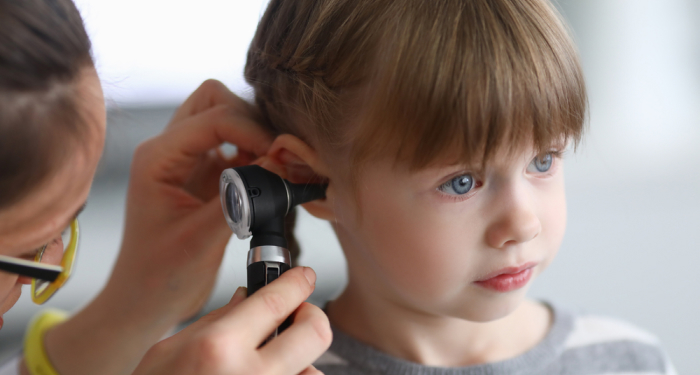Ear infections in children
Most growing children will experience an ear infection at some point. This is a quick guide to recognising the symptoms and causes and what treatments are best.
Generally speaking, when a child gets an ear infection, it often starts with a bacterial infection, a virus like the common cold. It can be painful for a child (and an adult!) because the middle ear can sometimes get inflamed, which in turn results in the build-up of fluid behind the eardrum. Other causes of pain include the narrow passageways (called the eustachian tubes) that connect the middle ear to the back of the nose become swollen.

For various reasons, kids are more prone to both of these problems. The passages in their ears are narrower, shorter and more horizontal than the adult versions. Because it’s easier for germs to reach the middle ear, it’s also easier for fluid to get trapped there. The other important factor is that children’s immune systems are immature – they’re still developing and not always adept at fighting off infection as fast as an adult can.
It’s not always easy for a parent to detect a child’s ear infection because a young child will often pull at their ear as a self-comforting measure, or generally play with their ears to explore them.
WHAT ARE THE SYMPTOMS OF AN EAR INFECTION?
Your doctor is the best person to examine and diagnose an ear infection in your child, However, if you suspect that your child is affected by this, you’ll want to check! These are the symptoms to look out for:
Pain
The most common symptom of an ear infection is pain. Older children can tell you that their ears hurt. Younger children may only seem irritable and cry. You may notice this more during feedings because sucking and swallowing may cause painful pressure changes in the middle ear.
Loss of appetite
Your child may have less of an appetite because of the ear pain.
Problems with sleeping
It stands to reason that if your child is in pain, they may have trouble sleeping.
Fever
Your child may have a temperature ranging from 100°F (normal) to 104°F.
Fluid leakage from the ears
You might notice yellow or white fluid, possibly blood-tinged, draining from your child’s ear. The fluid may have a ‘rotten’ smell. The pain and pressure your child feels will often decrease after this fluid leakage, but this doesn’t necessarily mean that the infection is resolved. If this happens it’s not an emergency, but your child will need to see your doctor.
Your child may have trouble hearing
During and after an ear infection, your child may have trouble hearing for somewhere up to 2-3 weeks. This happens because the fluid behind the eardrum interferes with their normal sound transmission. This hearing impairment is usually temporary and will resolve itself after the fluid from the middle ear drains away. You should get your child’s ear complaint seen by your doctor to test whether there are signs of inflammation or any accumulation of fluid.
OTHER CAUSES OF PAIN IN THE EARS
When a child experiences pain in their ears, it is possible that there are causes other than an infection. These include:
- An infection of the skin of the ear canal, often called ‘swimmer’s ear’.
- Reduced pressure in the middle ear from colds or allergies.
- A sore throat.
- Teething or sore gums.
- Inflammation of just the eardrum during a cold, without any fluid build-up present.
TREATMENT FOR EAR INFECTIONS
Unless a child is very young, or the ear infection is very severe, it’s not often that common childhood ear infections actually need medical treatment. An increasing number of studies show that a child’s natural immune defences can usually deal with ear infections, even though their immune system is not as strong as that of adults. One study compared two groups of children with ear infections.
One group was given antibiotics and the other did not receive any medication. The researchers were surprised to find that the level of healing was the same after ten days! Many doctors therefore have good reasons for taking a ‘wait and see’ approach, rather than prescribing antibiotics at the first sign of infection in a child. Your doctor may ask you to keep an eye on your child’s ear infection for 2-3 days, but that does not mean you should make that decision on your own! Your doctor may well give your child some numbing drops for the pain to help your child on a more comfortable path to recovery.
MINIMISING THE RISKS OF EAR INFECTIONS
Every parent wants nothing more than to keep pain and infection away from their child. While it’s not possible to protect children in this way, there are some measures you can take to reduce the risk of your child contracting an ear infection.
Breastfeeding
Breastfeeding is the best way to help your child to build up and strengthen their immune systems in the first year of life. The breast milk itself contains antibodies that can help your baby to fight infection. Through these antibodies, a nursing mother can even pass on some level of protection from infectious illness she has had in the past and give babies a head start in preventing and fighting infections.
Supervising good hygiene practice
When children spend time in different environments, such as school, they are more exposed to bacteria. Bacteria exposure can also result from drinking from poorly-cleaned bottles, cups and water bottles, which have more surface area upon which germs can attach. Help your children to learn about how a frequent hand washing habit can prevent the spread of germs that cause infections.
Childhood vaccinations
Research has shown that vaccinated children are prone to getting fewer ear infections than unvaccinated kids. Talk to your doctor about the vaccines that can protect against ear infections.












Comments